Is The African Mouflon An Invasive Species In Europe?

The African mouflon is considered an invasive species in Europe and especially Spain, although the concept has recently been questioned. Let’s find out together if the African mouflon is invading our territories.
Generality
Its scientific name is Ammotragus Iervia, it belongs to the goat family and is native to the African continent. Among its main features we find:
- Adult males can weigh up to 145 kg;
- They have very short fur of a reddish or light brown color, similar to that of the sand of the deserts where it normally lives. The tail is fluffy and long. Both male and female specimens have curved beards and horns, which in the case of the former are slightly longer. The horns can reach 60 cm.
- It is a purely herbivorous animal that feeds on lichens, herbs, branches, leaves and berries.
- They live in more or less numerous, mixed groups, made up of males of all ages, females and young. The females are in charge of directing the group. They usually only make a puppy.
- The life expectancy of this species is around 20 years.
Introduction of the African mouflon in Italy and the Iberian Peninsula
In Italy this species regularly lives in zoos and natural parks; only a small group escaped from one of these has settled on Mount Beigua and lives there free, without causing a real problem.
In Spain, the African mouflon was introduced together with the European mouflon in the 1970s following the demand for new species for hunting.

It was initially included in the Sierra Espuña Natural Park, in the Murcia region but, in the face of the abundance of food, the lack of natural predators and the high birth rate of the species, it has rapidly expanded to the point of being considered a invasive species.
Is it an exotic species?
In the beginning it was considered an exotic species, but recently fossils have been discovered that are classified at first sight as goats, but which following further research could be mouflons.
Is it an invasive exotic species?
Numerous experts believe that this animal can occupy and invade the space of the Iberian ibex, although there is no study that supports this theory.
Doctor Jorge Cassinello maintains that “the Iberian ibex and the African mouflon occupy the same ecological niche, although they do not coincide as regards the preferred area; the Iberian ibex prefers points of greater slope and altitude, relatively wooded, humid and far from inhabited centers and paths. The African mouflon is a species that likes to run more and less graze ”.
Of course, like any herbivore without a natural predator, the African mouflon is expanding and therefore requires proper management.

Opinions on this matter are mixed. While the African mouflon is considered a vulnerable or threatened species in the Mediterranean area, on the same level as the brown bear, in the Valencia area it has been cataloged as a species to be eradicated. Nevertheless, it currently coexists without problems with the cattle that graze in the mountains, with European mouflons and with deer.
The control of the African mouflon
It is necessary to manage and control the populations of herbivorous species, usually through controlled hunting trips and with awareness of how many specimens are to be killed. Mouflons are currently being hunted before the age of five, so far too early. For this reason, their kinetic management needs to be improved.
Scientific research recommends withdrawing the African mouflon from the list of invasive species. Because? Because his preference for cultivated meadows and fields promotes the biodiversity of the pastures, allows to clean up the mountain in a natural way and to maintain open areas that can act as natural firebreaks.










